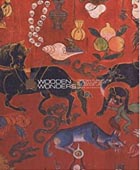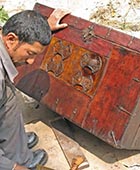Kachalinta, Kathmandu, Nepal
Kachalinta is based in Kathmandu and offers a collection of the finest, old, authentic Tibetan furniture, rugs, objects d'art and Himalayan tribal art. Each piece has been carefully selected to ensure the finest quality. Everything has been carefully cleaned and expertly restored, ready to be placed in your home. This web site is just to give a taste of what we have in stock.
 AUSPICIOUS BY DESIGN
AUSPICIOUS BY DESIGN
This book-catalogue of the personal collection of Luca and Camilla Corona's fine antique Tibetan Painted Furniture by Camilla Corona, Ed. Mera Publications, Nepal 2021 can be ordered through this web site.
 WOODEN WONDERS
WOODEN WONDERS
Each piece has been selected by Luca and Camilla Corona, co-authors of the article "Tibetan furniture, Its Construction and Use in Tibetan Society" in Serindia's publication WOODEN WONDERS: TIBETAN FURNITURE IN SECULARE AND RELIGIOUS LIFE. Ed. By David Kamansky, November 2004.
 RESTORATION
RESTORATION
In order to provide the best selection of fine, authentic furniture, each piece was carefully chosen so that a minimum of restoration was necessary. However, no piece of furniture from Tibet was ready to go directly into the showroom. Everything passed through the workshop, established in 1996. A professional restorer from Italy helped to perfect the mix of good local skills and expert restoration techniques. For the carpentery work, traditional methods of joining panels were used, and all nails that had been put in at a later date, were replaced by wooden pegs or "butterfly" joints. All the synthetic varnish was removed and the original paint work was then sealed with the traditional shellac polish. Every effort was made to maintain the authenticity of each piece.
 ORIGINAL, REPLICA OR FAKE
ORIGINAL, REPLICA OR FAKEThese days, authentic Tibetan furniture is increasingly difficult to find and is, quite rightly, considerably more expensive than replicas or re-painted pieces. Without an expert eye it can be difficult to spot the difference, especially the furniture re-painted on old pieces designed to deceive. It is also hard to determine the state of the original paintwork without removing the heavy synthetic varnish applied almost universally to furniture in Tibet these days.
